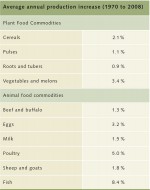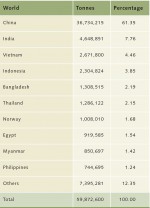- 4.1 > No other food production sector has achieved such high growth rates as aquaculture in the past 40 years.
Fish for 9 billion people
The global population is growing at a breathtaking pace. In 1950 the world had a total of 2.5 billion people, a figure that had burgeoned to 7 billion by 2012. According to United Nations estimates, this number could exceed the 9 billion mark by mid-century. As populations increase, so too does the need for food. Fish is a widespread, affordable and healthy source of valuable protein. There is no question, therefore, that the global demand for fish will intensify in future.
When we consider that the amount of wild-captured fish has not increased in recent years, only one alternative remains: fish farming, or aquaculture, must fill the gap. Is it capable of doing so? This is the question many scientists around the world are trying to answer.
For many years aquaculture played a relatively minor role in global fish production, but its significance has increased dramatically over the past 20 years, spurred by the demand from Asia’s fast-growing populations. Today, aquaculture makes a major contribution to human nutrition. For example, it provides a large proportion of the animal protein consumed in China, Bangladesh and Indonesia. Global production of fish, mussels and crab in 2010 was almost 60 million tonnes, a figure which includes production in marine waters, brackish water and freshwater. Aquaculture production is now about three quarters of that from ocean fish and seafood caught in the wild. In 2011 this amounted to 78.9 million tonnes.
No other food industry has shown such growth as aquaculture in recent decades. Between 1970 and 2008 annual production worldwide increased by an average of 8.4 per cent; much more than poultry farming and egg production, which have the second highest growth rates after aquaculture.
- 4.2 > Asia dominates world aquaculture. The total output of the top ten producer countries worldwide is shown. The amounts of farmed algae and aquaculture products not used as food are not included
Asia – the cradle of fish farming
Aquaculture is not equally important in all countries and all regions. For instance, central Europe in general prefers its fish to be caught in the wild. In China on the other hand, fish farming is widespread and has enjoyed a millennia long tradition, since carp were first domesticated. China is still the undisputed leader in aquaculture production. Since 1970 it has recorded annual growth rates in aquaculture production of an average 10 per cent, although recently these have slowed to about 6 per cent. Today 61 per cent of global production comes from China, with Asia as a whole supplying a massive 89 per cent. This figure includes both fish farming inland (in freshwater) and in coastal areas.
The proportion generated in the other world regions is therefore small. Europe and America produced approximately 2.5 million tonnes each in 2010, Africa a little below 1.3 million tonnes and Oceania less than 200,000 tonnes.
For a long time aquaculture in many Asian countries has mainly provided food for local populations. Nations such as Thailand and Vietnam traditionally farm fish in the flooded rice fields; many people catch their lunch or evening meal from the neighbouring rice paddy. This widespread peasant practice, never captured in actual numbers, makes it difficult to estimate the actual extent of aquaculture production. For this reason experts assume that some Asian states produce totals even greater than those quoted in the statistics.
What is certain, however, is that aquaculture has not developed equally in all Asian states. The 10 largest producers alone generate 53 million tonnes, a massive 86 per cent of global aquaculture production, with the remaining Asian states producing only about 1.5 million tonnes. These countries still use only small amounts of farmed fish for their own consumption needs.
Modest growth in America and Europe
Between 1970 and 2000 aquaculture production in America and Europe grew by 4 to 5 per cent per annum. Since then it has increased by a moderate 1 to 2 per cent a year. Chile is the most important producer in America, since major salmon farms were established there over the last 20 years. In 2010 Chile supplied a good 700,000 tonnes of farmed fish, mainly salmon. The second largest producer on the American continent is the USA with slightly under 500,000 tonnes of fish.
Norway is the most important aquaculture nation in Europe, with about 1 million tonnes of farmed fish, followed by Spain with a good 250,000 tonnes; France takes third place with 220,000 tonnes. The main aquatic products farmed in Europe are salmon, rainbow trout, eel and carp.Aquaculture – a prospect for Africa?
Developments in Africa are of paramount interest. Although aquaculture production was barely 1.3 million tonnes in 2010, experts nonetheless expect to see fish farming become further established in Africa. It would enable the – relatively easy – generation of large amounts of valuable protein for the growing population. Egypt is the trailblazer here, with large numbers of finfish (tilapias, mullets and catfish) being farmed in the Nile Delta. Aquaculture is also expected to grow wherever fish is a traditional food, but where insufficient wild fish will be available to meet the growing demand.
The lack of wild fish, particularly in urban centres, is forcing a change in thinking. Take Lagos, the capital of Nigeria, on the Gulf of Guinea as an example. The people living around the Lagos Lagoon have always farmed catfish for their own use, but now the early stages of commercial aquaculture are becoming evident, and further expansion is expected. Similar developments are being seen in Accra, the capital of Ghana, and Lusaka, the capital of Zambia. Small and medium-sized businesses are also becoming involved in Zambia and Uganda, with the aim of operating commercial aquaculture on a large scale. Experts are praising these approaches, because they believe this is the only way of making enough fish available to supply local markets.
Furthermore, there is great interest in the large-scale expansion of fish farming in countries such as South Africa. For about 5 years now a national aquaculture association has been involved in setting up aquaculture operations. Some of the technology applied will be exported to other African nations, although in some countries the importation of the facilities is still complicated by exorbitantly high duties. In many other regions of Africa, however, an aquaculture industry is still a long way off. For this reason non-governmental organizations (NGOs) have been trying for some years to encourage aquaculture among individual communities.
With the exception of a few nations, aquaculture in Africa is still at an embryonic stage, and its potential is far from being exploited. It will take at least 10 years before any appreciable production increases are seen. Unfortunately, even if strong expansion should occur, aquaculture is unlikely to be able to keep pace with the needs of the fast-growing population.
- 4.3 > Marine water, brackish water and freshwater – aquaculture production has shown strong growth in all areas over the past 30 years.
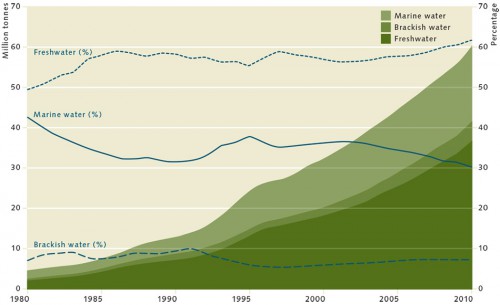
From salmon to pangasius – aquaculture products
About 600 species are raised worldwide by aquaculture. Depending on local traditions and preferences, different species are in high demand in different regions of the world. The species raised include fish, crabs, mussels, amphibians (frogs), aquatic reptiles, sea cucumbers, jellyfish and sea squirts (fleshy organisms which live on the sea floor and filter the water). China farms mussels and carp in particular, and in terms of the latter, has done so for several thousand years. The carp is also a popular farmed fish throughout the rest of Asia. Finfish are found here, too, along with catfish and shrimps, and prawns which are exported all over the world. For some years now a popular Asian export fish has been the pangasius, of which there are several different species. These catfish are white-fleshed, neutral-tasting and almost bone-free. At first it was necessary to catch juvenile fish in the wild for breeding purposes, but in the early 1990s a French-Vietnamese project succeeded in breeding two types of pangasius in captivity. Only then was it possible to breed the fish in large numbers, allowing its export on a grand scale. Today the export of pangasius is a global winner.
In Europe, however, the farming of mainly salmonids is preferred, including salmon and trout along with turbot and mussels. Only small numbers of carp and other finfish are bred in captivity. In the past 10 years production of sea bass, common dentex and gilthead seabream has expanded, particularly in Greece, Italy and Turkey, mostly in net cages in coastal bays.
Salmonids are also the dominant group of farmed fish in South America, mainly in Chile, followed in equal parts by shrimps, prawns and mussels. Shrimps and prawns, catfish, mussels and salmonids are farmed in North America, mainly in Canada. Tilapia, catfish and other finfish are of particular interest in Africa, while shrimps and prawns predominate in Oceania.
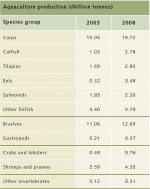 4.4 > In terms of aquaculture production, carp is the most important fish worldwide.
4.4 > In terms of aquaculture production, carp is the most important fish worldwide.Algae for Asia
The cultivation of algae is less widespread than that of aquatic animals. It is only practised in about 30 countries throughout the world, predominantly in Asia. In most cases cultivation is of large algae such as kombu (Laminaria japonica), a Japanese seaweed which is several metres long. It is now farmed mainly in marine water and brackish water along the coast of China. Kombu is often used as a soup ingredient. Although the 19 million tonnes of algae produced in 2010 was much less than farmed aquatic animals, nonetheless its growth rate has been similarly strong in recent years – an average of 9.5 per cent per annum during the 1990s and 7.4 per cent in the past decade. In 1990 global algae production was 3.8 million tonnes. The most important regions are China (58.4 per cent of global production), Indonesia (20.6 per cent) and the Philippines (9.5 per cent). Most of the algae produced worldwide is used in the cosmetics, chemical and food industries. Only a small proportion is used for human consumption, as a base for soups. The tropical algae Eucheuma and Kappaphycus, harvested throughout the Indo-Pacific region between the island of Zanzibar and the Philippines, are also of significance. They offer many fishermen an additional income and are utilized in the chemical, health and biological industries as a bacterial growth medium.
- 4.5 > Fish can convert feed into body mass much more efficiently than birds or mammals. They provide a great deal more mass per kilogram of feed.
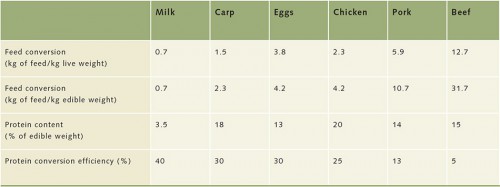
The strengths and weaknesses of aquaculture
Aquaculture has come in for some hefty criticism in recent years. For various reasons it still attracts controversy. Food, faecal and metabolic wastes from intensive fish farms can lead to the eutrophication (over-fertilization) of water in rivers and coastal bays. There have also been complaints that fish farmed under intensive conditions for maximum yields are more susceptible to disease than their relatives in the wild. Tremendous amounts of anti-biotics and other medications are used to fight disease, particularly in relation to shrimp on farms in South East Asia – with unforeseeable consequences for surrounding ecosystems and consumer health. In some cases these points are valid, but they should not detract from the fact that aquaculture can be a very efficient and sustainable method of supplying humans with animal proteins – and counteracting over-fishing.
The farming of the classic common carp or mirror carp provides a positive example of environmentally-sound aquaculture. Carp are bottom feeders, generally eating small aquatic animals, plants, dead plant matter and waste material which gather on the pond floor. They also sieve the water to extract suspended solids, thus helping to keep the water clean. Carp ponds often have very clear water. Intensive mussel farming also helps to keep the water clean. Mussels filter large amounts of water, sieving out tiny particles of food, thus counteracting the over-fertilization of water and algal blooms.
- 4.6 > In Belize, in Central America, the construction of huge aquaculture facilities has involved the destruction of large tracts of land and mangroves. The effluent is discharged to the sea without any prior treatment. Such operations have brought the sector into disrepute.
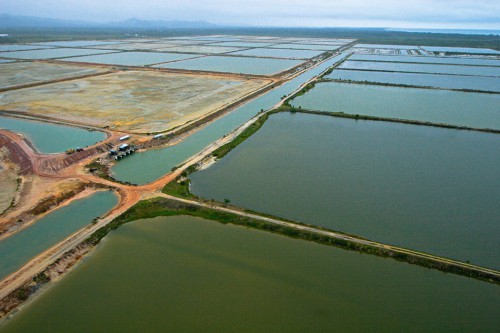
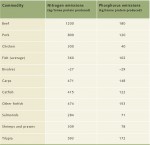 4.7 > Aquaculture emits much less nitrogen and phosphorus per tonne of produced protein than livestock farming. Farmed mussels even lower nitrogen and phosphorus levels as they filter the water. However, this also means that mussels from highly polluted waters can themselves contain high nitogen and phosphor levels.
4.7 > Aquaculture emits much less nitrogen and phosphorus per tonne of produced protein than livestock farming. Farmed mussels even lower nitrogen and phosphorus levels as they filter the water. However, this also means that mussels from highly polluted waters can themselves contain high nitogen and phosphor levels.- Although the nutrient-rich effluents from aquaculture facilities can lead to problems in rivers or coastal areas, nonetheless many fish farms are more environmentally-friendly than, for instance, the intensive farming of pigs or cattle. The latter emit large quantities of nitrogen and phosphorus from the slurry and manure used to fertilize the land. Aquaculture produces far lower emissions of nitrogen and phosphorus and can roughly be compared with those from the much less problematic farming of poultry. This is made abundantly clear by the example of the Mekong Delta. Only about 1 to 2 per cent of nutrient inflows into the delta come from pangasius aquaculture. The majority comes from agriculture, the production of vegetables and fruit as well as from untreated municipal sewage and industrial effluent. Aquaculture also scores well when compared to livestock breeding because fish and other aquatic organisms need less nourishment to build body mass than land animals. Therefore a lot less feed is required to produce 1 kilogram of carp than to produce 1 kilogram of chicken, beef or pork. One reason for this is that fish are cold-blooded creatures, meaning that their body temperature is approximately the same as that of their surroundings. They therefore need far less energy to produce heat than warm-blooded mammals or birds. Also, it takes greater expenditure of energy to move on land than in the water. As water is denser than air, it provides buoyant lift to the body, meaning that fish are supported without the development of heavy skeletal mass. Many marine animals such as mussels, snails and sea cucumbers also manage without an internal skeleton. This saves them the energy they would otherwise use to build bones. Fish have another energy advantage, too: they are capable of releasing into the water (as ammonium, a simple chemical compound) any surplus nitrogen they may have absorbed with their food. In contrast, land-based animals have to use energy to convert nitrogen into urea or uric acid. Only in this chemical form are they able to excrete the nitrogen with their faeces or urine.
Fish for all?
In an international collaboration scientists have investigated whether aquaculture and commercial fishing will be capable of meeting the global demand for fish in 2050. They are optimistic, believing that yes, they can. How-ever, this would depend upon the world’s fish stocks being managed sustainably in the long term. Also, the fish used as feed in aquaculture in the form of fishmeal and fish oil must be utilized more efficiently. Scientists have also queried the predicted direct impact of climate change and ocean warming on potential marine fisheries procduction. They have concluded that the amount of wild marine fish available for fisheries worldwide will probably be re-distributed due to climate change and predict a slight 6 per cent overall increase on marine fisheries potential.

